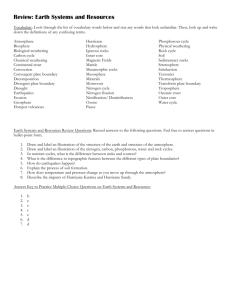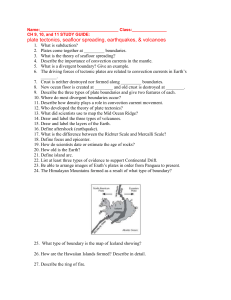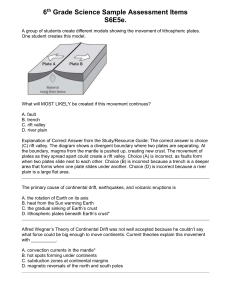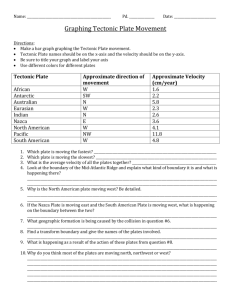Boundary element method applied to the bending analysis of thin
advertisement
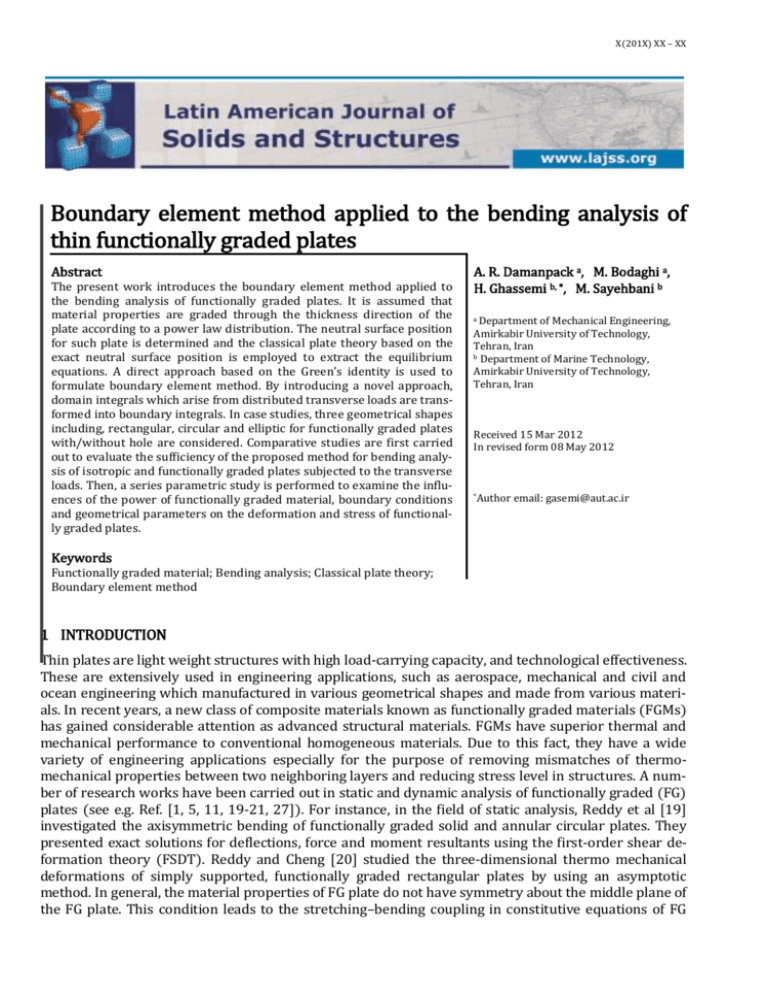
X(201X) XX – XX
Boundary element method applied to the bending analysis of
thin functionally graded plates
Abstract
The present work introduces the boundary element method applied to
the bending analysis of functionally graded plates. It is assumed that
material properties are graded through the thickness direction of the
plate according to a power law distribution. The neutral surface position
for such plate is determined and the classical plate theory based on the
exact neutral surface position is employed to extract the equilibrium
equations. A direct approach based on the Green’s identity is used to
formulate boundary element method. By introducing a novel approach,
domain integrals which arise from distributed transverse loads are transformed into boundary integrals. In case studies, three geometrical shapes
including, rectangular, circular and elliptic for functionally graded plates
with/without hole are considered. Comparative studies are first carried
out to evaluate the sufficiency of the proposed method for bending analysis of isotropic and functionally graded plates subjected to the transverse
loads. Then, a series parametric study is performed to examine the influences of the power of functionally graded material, boundary conditions
and geometrical parameters on the deformation and stress of functionally graded plates.
A. R. Damanpack a, M. Bodaghi a,
H. Ghassemi b, , M. Sayehbani b
a Department
of Mechanical Engineering,
Amirkabir University of Technology,
Tehran, Iran
b Department of Marine Technology,
Amirkabir University of Technology,
Tehran, Iran
Received 15 Mar 2012
In revised form 08 May 2012
*Author
email: gasemi@aut.ac.ir
Keywords
Functionally graded material; Bending analysis; Classical plate theory;
Boundary element method
1 INTRODUCTION
Thin plates are light weight structures with high load-carrying capacity, and technological effectiveness.
These are extensively used in engineering applications, such as aerospace, mechanical and civil and
ocean engineering which manufactured in various geometrical shapes and made from various materials. In recent years, a new class of composite materials known as functionally graded materials (FGMs)
has gained considerable attention as advanced structural materials. FGMs have superior thermal and
mechanical performance to conventional homogeneous materials. Due to this fact, they have a wide
variety of engineering applications especially for the purpose of removing mismatches of thermomechanical properties between two neighboring layers and reducing stress level in structures. A number of research works have been carried out in static and dynamic analysis of functionally graded (FG)
plates (see e.g. Ref. [1, 5, 11, 19-21, 27]). For instance, in the field of static analysis, Reddy et al [19]
investigated the axisymmetric bending of functionally graded solid and annular circular plates. They
presented exact solutions for deflections, force and moment resultants using the first-order shear deformation theory (FSDT). Reddy and Cheng [20] studied the three-dimensional thermo mechanical
deformations of simply supported, functionally graded rectangular plates by using an asymptotic
method. In general, the material properties of FG plate do not have symmetry about the middle plane of
the FG plate. This condition leads to the stretching–bending coupling in constitutive equations of FG
2
A. R. Damanpack et al / Boundary element method applied to the Bending Analysis of Thin Functionally Graded Plates
plate. Abrate [1] showed that there is no stretching–bending coupling in constitutive equations of FG
plates, if the reference surface is properly selected. Zhang and Zhou [27] presented a theoretical analysis to the FG thin plates based on the physical neutral surface. They carried out the bending, buckling
and free vibration analysis of simply supported rectangular and clamped circular FG plates. Recently,
Bodaghi and Saidi [5] developed an exact analytical solution for buckling of functionally graded rectangular plates subjected to non-uniformly distributed in-plane loading acting on two opposite simply
supported edges.
As mentioned above, analytical solutions of plate problems using classical methods is limited to
relatively simple plate geometry, load configuration, and boundary supports. If these conditions are
more complicated, the classical analysis methods become increasingly tedious or even impossible. In
such cases, approximate methods are the only approaches that can be employed for the solution of
practically important plate problems. The boundary element method (BEM) is a popular computational
tool among numerical methods. The BEM is well suited for treating complicated boundaries, for discontinuous internal actions, mixed boundary conditions, etc. In particular, the BEM has been applied successfully for the solutions of plate bending problems, its advantages have been demonstrated [3, 4, 6, 8,
12, 15, 22, 23, 26]. One of the main advantages of this method is a possibility of reduced dimensionality
of the problem which leads to a reduced set of equations and makes smaller amount of data required
for computation. For the linear problem, the BEM is especially effective because integral equations are
formulated only on the boundary of the domain under consideration. The various boundary element
formulations for thin plate bending can be generally categorized as the direct and the indirect formulations. The first boundary element formulation was based on the so-called indirect methods [12], where
the integral equations do not relate to the natural variables of the problem, such as deflections, rotations, bending or twisting moments and shear forces. Instead, they involve some source distribution
densities, apparently without any physical meaning. Some authors have followed the same bases to
propose alternative indirect schemes [3, 26]. The natural variables appearing in the integral equations
gave origin to the direct methods applied to plate bending, as in Bezine [4], Stern [22] and Tottenham
[23]. They established the main bases of the boundary element technique for plate bending, nowadays
used as a standard tool.
In the general plate bending boundary element method, domain integrals arise in the formulation
owing to the distributed load on the domain. The fact that domain integrals need to be evaluated spoils
the pure boundary character of the BEM and weakens the advantages this method has over domain
methods. During the past three decades, various techniques such as Galerkin tensor method [6], dual
reciprocity method [15], multiple reciprocity method [16] and radial integration method [8] have been
developed that successfully overcome this problem and at the same time preserve the purely boundary
character of the BEM. A brief comment on the popularly used transformation methods was described
by Gao [8].
Using the direct boundary element method based on Green’s identity, Gospodinov and Ljutskanov [10]
investigated the static analysis of thin rectangular plates. They discretized the plate domain to solve
domain integrals in their BEM formulation. They also used the indirect boundary element method for
dynamic and stability analyses of the plates. Du et al. [7] presented some fundamental aspects of the
direct boundary element method of the Kirchhoff theory of thin plate. The boundary element results of
plates in bending can exhibit disturbances in the vicinity of points where abrupt changes in the boundary conditions occur. Due to this event, Venturini and Paiva [24] proposed several different ways of
defining the boundary element system of equations to improve their numerical responses and consequently to increase the reliability of the technique. Paris and de Leon [17] formulated the thin plate
bending problem by means of two coupled Poisson equations. The domain integrals were evaluated
approximating the integrands by a series of simple domain functions whose coefficients were calculated by a collocation procedure at points placed along the boundary and domain. Recently, Leonetti et al.
[14] presented a symmetric model for the boundary element analysis of Kirchhoff plates. They showed
that the convergence of their model is more regular than the collocation boundary model.
Latin American Journal of Solids and Structures X(201X) XX – XX
A. R. Damanpack et al / Boundary element method applied to the Bending Analysis of Thin Functionally Graded Plates
3
Although some research works dealt with bending analysis of thin isotropic plates, but there are
few research works that dedicate to the bending analysis of non-homogeneous plate. For example, Paiva et al. [18] presented an approach for anisotropic thin-plate bending problems using the boundary
element formulation when the source points were located on the boundary. Albuquerque et al. [2] presented a boundary element formulation without any domain integral for anisotropic plate bending
problems using the radial integration method. A robust boundary element method that can be used to
solve elastic problems with nonlinearly varying material parameters, such as the functionally graded
material and damage mechanics problems was presented by Gao et al. [9]. Recently, Ruocco and Minutolo [21] investigated two-dimensional stress analysis of multi-region functionally graded materials
using a field boundary element model.
To the best of authors’ knowledge, there is no research work on the bending analysis of functionally
graded plate based on the boundary element method.
The present work develops a pure boundary element method for bending analysis of functionally
graded plates based on the classical plate theory (CPT) and physical neutral surface concept. The material properties of the FG plate are assumed to vary continuously and smoothly through the thickness
according to the power-law distribution of the volume fraction of the constituents. The equilibrium
equations are derived from the principle of minimum total potential energy. The direct boundary element method is employed to solve plate bending problem. By introducing a novel approach and using
auxiliary potential functions, domain integrals which arise from distributed loads are transformed into
boundary integrals. To certify the accuracy of the present boundary element method, the results obtained by the present analysis are compared with those available in the literature. Moreover, the effects
of power of FGM and geometrical parameters together with various combinations of boundary conditions on the deformation and stress of FG plates are investigated in detail.
2. EQUILIBRIUM EQUATIONS
2.1 Physical neutral surface concept
The material properties of FGMs vary smoothly and continuously from one surface to the other. This
is achieved by gradually varying the volume fraction of the constituent materials. FGMs are usually
made from a mixture of metal and ceramic, or a combination of different metals. In the present work,
it is assumed that the FG plate is made of ceramic and metal. Since, the material properties of the FG
plate vary through the thickness direction, the neutral surface of such plate may not coincide with its
geometric middle surface. Therefore, stretching and bending deformations of FG plates are coupled.
Some researchers [1, 5, 27] have shown that there is no stretching-bending coupling in constitutive
equations if the origin of coordinate system is suitably selected in the thickness direction of the FG
plate so as to be the neutral surface. To specify the position of neutral surface of FG plates, two different planes are considered for the measurement of z , namely, z ms and z ns , as depicted in Fig. 1.
Fully metallic surface
Middle surface
Neutral surface
Fully ceramic surface
Figure 1 The position of middle surface and neutral surface for a functionally graded plate.
Latin American Journal of Solids and Structures X(201X) XX – XX
4
A. R. Damanpack et al / Boundary element method applied to the Bending Analysis of Thin Functionally Graded Plates
The volume-fraction of metal (V m ) can be expressed based on these coordinates as [5, 27]:
(1)
where h is the thickness of the plate, the parameter D is the distance of neutral surface from the
middle surface and n denotes the power of FGM (n ³ 0) . The effective Young’s modulus (E ) based
on the Voigt model can be expressed as:
(2)
where
and
are the Young’s modulus of the metal and ceramic, respectively. The situation of
the neutral surface of the FG plate is determined to satisfy the first moment with respect to Young’s
modulus being zero as follows [5, 27]:
(3)
Therefore, the position of neutral surface can be obtained as:
(4)
Eq. (4) shows that the distance of neutral surface from the middle surface
geneous isotropic plates.
is zero for homo-
2.2 Governing equations
According to the classical plate theory and physical neutral surface concept, the displacement
components of a material point within the plate domain in Cartesian coordinates system can be written as:
(5)
where
and w are the displacements of neutral surface of FG plate along the
and
coordinate directions, respectively.
Substituting Eqs. (5) into linear strain–displacement relationship, kinematic equations are obtained as:
(6)
Latin American Journal of Solids and Structures X(201X) XX – XX
A. R. Damanpack et al / Boundary element method applied to the Bending Analysis of Thin Functionally Graded Plates
5
where
;
;
(7)
The constitutive relations of the plate in the plane stress state are expressed as [25]:
(8)
where
;
(9)
The parameter n is Poisson ratio and it is assumed to be constant through the thickness of the FG
plate [1, 5, 19, 20, 27]. By using the principle of minimum total potential energy, the equilibrium
equations of plate are derived as follows:
(10)
where d represents the variational symbol;
is the mechanical load per unit area, and
N and M are resultant forces and resultant moments, respectively, which are defined by the following expressions
;
(11)
Substituting Eq. (6) into Eq. (9) and the subsequent results into Eqs. (11), gives the stress resultants in term of the displacements as:
N A 0 ; M D1
(12)
where
(13)
Latin American Journal of Solids and Structures X(201X) XX – XX
6
A. R. Damanpack et al / Boundary element method applied to the Bending Analysis of Thin Functionally Graded Plates
and
h
2
h
E ( z )
E ( z ns )
2
ns
dz ns ; D h
z ns2 dz ns
2
2
(
1
)
(
1
)
2
2
A h
(14)
The matrices A and D are extensional and bending stiffness matrices. Eq. (12) reveals the fact
that there is no stretching-bending coupling matrix, and subsequently, the coupling in the constitutive equations when the physical neutral surface concept is utilized.
Finally, the bending equation of the FG plate may be obtained upon substitution of Eqs. (12) into Eq.
(10) as below:
(15)
where
Ñ 2 is known as the Laplace operator, and the constant D is the equivalent flexural rigi-
dity of the FG plate which is simplified as Dm
Em h3
12(1 2 )
E h3
and Dc 12(1c 2 ) for a homogeneous fully
metallic and ceramic plates, respectively.
Utilizing the boundary element method, the bending equation (15) will be solved for stress
analysis of FG plates in the next section.
3. BOUNDARY ELEMENT FORMULATIONS
3.1. Fundamental solution
Considering Eq. (15), the boundary element formulation is now well established [13]. Let us consider
a point source placed at point P (x , y ) of the xy -plane as shown in Fig. 2a. Its density at
can be
expressed by Dirac delta function as follows:
(16)
Figure 2 Geometry and modeling of boundary domain: (a) Coordinate system, (b) Modeling of the boundary with superparametric
elements, (c) Definition of nodal-point location, relative distance and relative angle.
Latin American Journal of Solids and Structures X(201X) XX – XX
A. R. Damanpack et al / Boundary element method applied to the Bending Analysis of Thin Functionally Graded Plates
The deflection
7
produced at point Q satisfies the governing equation as follows:
(17)
A singular particular solution of Eq. (17) is called the fundamental solution of the governing equation (15). Applying Green’s second identity for w and Ñ 2v yields:
(18)
where n is normal to the boundary G . Using Eq. (18) and following Ref. [17], the fundamental
solution can be obtained as
.
The governing equation (15) can be written in the new form by introducing a potential function
as:
(19)
where
(20)
By considering Eqs. (17), (19) and (20), and also using Green’s second identity for j and n , the
representation of integral equation (18) can be rewritten as follows:
(21)
where eP is a coefficient which depends on the position of point P . This coefficient for the
smooth boundary is defined as follows [13]:
(22)
It should be noted that the integral representation of the solution (21) involves the following domain integral:
.
(23)
Although the integrand v DF is known, the fact that domain integral need to be evaluated spoils the
pure boundary character of the method. In the present work, to overcome this drawback, a novel
procedure is introduced by converting the domain integral (23) to a boundary integral. To this end,
an auxiliary function called v is assumed by satisfying the following equation:
Latin American Journal of Solids and Structures X(201X) XX – XX
8
A. R. Damanpack et al / Boundary element method applied to the Bending Analysis of Thin Functionally Graded Plates
(24)
Then, Green’s second identity for v and Ñ 2 v is written as:
(25)
Now, by substituting Eq. (24) into Eq. (25) and using of Green’s second identity for v and v ,
the following equation can be obtained:
2
(26)
It is seen that the domain integral (23) has been successfully converted to the above boundary
integral. Finally, substituting Eq. (26) into Eq. (21) yields:
(27)
In Eq. (27), the quantity j and its derivation j n are unknown. To specify these quantities, a new
potential function called u and satisfied the following Laplace equation is assumed.
(28)
In the well-known procedure as expressed in Ref. [13], the fundamental solution u can be derived as
.
By virtue of Eqs. (19) and (28), Green’s second identity for j and u can be written as:
(29)
It can be seen that the integral representation of the solution (29) involves the domain integral.
To convert this domain integral to a boundary integral, similar process that was presented for Eq.
(23) were carried out.
An auxiliary function by satisfying the following Poisson equation is considered as:
(30)
Applying Green’s identity for the functions u and u that satisfies Eq. (30) yields:
(31)
Substituting Eq. (31) into Eq. (29) gives:
Latin American Journal of Solids and Structures X(201X) XX – XX
A. R. Damanpack et al / Boundary element method applied to the Bending Analysis of Thin Functionally Graded Plates
9
(32)
Thus, the bending equation of FG plates (15) is reformulated into two dependent boundary integral solutions (27) and (32).
3.2 The BEM with superparametric boundary elements
In the present work, superparametric elements are employed to discretize the plate boundary [13].
The boundary
is discretized into
superparametric elements (see Fig. 2b), which are numbered
in the counter-clockwise sense. The geometry is modeled by a parabolic arc (two degree polynomial),
whereas the boundary quantity is assumed to be constant along the element and equal to its value at
the nodal middle point. The discretized form of Eqs. (27) and (32) are expressed for a given point
on
as:
(33)
(34)
where
Also,
is the segment on which the
is the nodal point of the
node is located and over which integration is carried out.
element which remains constant, while the point
varies over
the
element (see Fig. 2b). Definition of all parameters presented in Eq. (33) and (34) are expressed as follows:
(35a)
,
,
(35b)
(35c)
where
is the angle between the vector
at point q and the
and
and the unit vector n which is normal to the boundary
are the shape function and elemental position vectors, respectively.
Latin American Journal of Solids and Structures X(201X) XX – XX
10
A. R. Damanpack et al / Boundary element method applied to the Bending Analysis of Thin Functionally Graded Plates
Equations (33) and (34) are applied consecutively for all the nodes
tems of
yielding two sys-
linear algebraic equations, which are arranged in matrix form as follows:
(36)
(37)
These two systems of equations are coupled and should be simultaneously solved. Prior to solving
them, it is necessary to separate the unknown from the known quantities which is possible by applying the plate boundary conditions.
3.3. Application of boundary conditions
The functionally graded plate boundary can be any combination of clamped, simply supported and
free boundary conditions. These boundary conditions which are developed from the principle of minimum total potential energy can be expressed in terms of normal and tangential coordinates as follows:
Clamped: w = w,n = 0
(38a)
Simply supported: w = M n = 0
(38b)
Free: M n = Qeff = 0
(38c)
where M n and Qeff are the resultant normal moment and the effective shear force, respectively,
which are defined as:
1
M n D 2 w (1 )( w, n w,tt )
R
(39a)
1
Qeff D 2 w, n (1 )( w,tt w, ntt )
R
(39b)
where the Laplacian has the form:
Ñ2 =
¶2 1 ¶ ¶2
+
+
¶n2 R ¶n ¶t 2
(40)
in which R is the radius of curvature of boundary. By using Eq. (20), these boundary conditions can
be simplified for j th node as follows:
Clamped: w j = w,nj = 0
Simply supported: w j 0
Latin American Journal of Solids and Structures X(201X) XX – XX
and
(41a)
j
1 j
w,n
Rj
(41b)
A. R. Damanpack et al / Boundary element method applied to the Bending Analysis of Thin Functionally Graded Plates
Free: , nj (1 ) (
1 j
w,tt w, jntt )
Rj
and
j (1 ) (
1 j
w, n w,ttj )
Rj
11
(41c)
The known boundary conditions are applied at nodal points, and then Eqs. (36) and (37) are rearranged according to unknowns nodal parameters. The prescribed quantities are multiplied by their
influence vectors and added to the right-hand side, and the unknowns and their influence vectors are
placed on the left-hand side, thus leading to two standard sets of linear algebraic equations in terms
of unknown nodal values as:
[ C9 ]{ X } + [ C10 ]{ Y } = { C11 }
(42a)
[ C12 ]{ X } + [ C13 ]{ Y } = { C14 }
(42b)
which can be solved for unknown boundary values at each boundary point. Once these unknown
boundary values have been obtained, it is possible to calculate any of the required internal values,
using Eqs. (27) and (32). Moreover, the partial derivatives of w and can be evaluated at points
within domain by direct differentiation of Eqs. (27) and (32) for
P 1.
4 NUMERICAL RESULTS AND DISCUSSION
In order to present the results of developed boundary element method, the three geometrical shapes
for a functionally graded plate including, rectangular, circular and elliptic shapes with/without hole
are considered. The geometry and dimensions of mentioned plates are given in Fig. 3.
(a)
(b)
(c)
Figure 3 Geometry and dimensions of the FG plates: (a) rectangular, (b) annular, (c) elliptic.
4.1 Comparative and convergence studies
To validate the present formulation and ensuring the accuracy and convergence of the proposed
boundary element method, several bending analyses of thin plates are first solved and results are
compared with those that are available in the literature for isotropic homogenous annular and rectangular plates [25] and functionally graded circular plates [19] subjected to transverse uniformly
distributed load. Also, the study of convergence is implemented by increasing the boundary elements
for the plate.
Latin American Journal of Solids and Structures X(201X) XX – XX
12
A. R. Damanpack et al / Boundary element method applied to the Bending Analysis of Thin Functionally Graded Plates
For the transverse uniformly distributed load, the auxiliary functions v and u presented in Eqs.
(26) and (34) are given as follows:
æ x 2 + y2 ö
v= ç
è 8 ÷ø
2
F
D
(43a)
(43b)
In Table 1, the non-dimensional maximum deflection and resultant moments obtained from the
present BEM are compared with the exact closed form solution obtained by Ventsel and Krauthammer [25] for bending analysis of isotropic simply supported rectangular plates with different aspect
ratios (L / W ) . The plate has been modeled in two cases with 20 and 40 boundary elements. From
this table, it is observed that the present BEM converges exactly when the number of boundary elements increases. Furthermore, in Table 2, the non-dimensional maximum deflection of an isotropic
annular plate with different boundary conditions obtained from the present BEM are compared with
those obtained from the exact solution given by Ventsel and Krauthammer [25]. The annular plate
with a clamped (or simply) support at the inner edge (r = Ri ) and free at the outer edge (r = Ro ) is
named as clamped (or simply supported)-free annular plate and vise versa. It is seen from Table 2
that the results of proposed BEM are in good correlation with the exact results as maximum discrepancy is about 0.59 % when 300 boundary elements have been used.
Table 1 Convergence test of the non-dimensional maximum deflection and resultant moments for isotropic simply supported
rectangular plates.
Aspect
ratio
(L / W )
1
2
3
4
*The
†The
wD
FL4
Method
w* =
Exact solution [25]
Present BEM-40*
Present BEM-20
Exact solution [25]
Present BEM-40
Present BEM-20
Exact solution [25]
Present BEM-40
Present BEM-20
Exact solution [25]
Present BEM-40
Present BEM-20
0.2600
0.2600 (0.00%)†
0.2612 (-0.46%)
0.0405
0.0405 (0.00%)
0.0408 (-0.74%)
0.0097
0.0097 (0.00%)
0.0097 (0.00%)
0.0032
0.0032 (0.00%)
0.0032 (0.00%)
M xx*
M xx
FL2
0.0479
0.0479 (0.00%)
0.0480 (0.00%)
0.0116
0.0116 (0.00%)
0.0116 (0.00%)
0.0045
0.0045 (0.00%)
0.0045 (0.00%)
0.0024
0.0024 (0.00%)
0.0024 (0.00%)
M *yy
M yy
FL2
0.0479
0.0479 (0.00%)
0.0480 (-0.20%)
0.0254
0.0254 (0.00%)
0.0255 (-0.39%)
0.0132
0.0132 (0.00%)
0.0133 (-0.75%)
0.0077
0.0077 (0.00%)
0.0077 (0.00%)
number of boundary elements used in the present BEM
discrepancy
Table 2 Convergence test of the non-dimensional maximum deflection (w* 64 w4D ) for isotropic annular plates with various boundary
FRo
Latin American Journal of Solids and Structures X(201X) XX – XX
A. R. Damanpack et al / Boundary element method applied to the Bending Analysis of Thin Functionally Graded Plates
13
conditions.
Annularity
( Ro / Ri )
2
4
Method
Exact solution [25]
Present BEM-300
Present BEM-150
Exact solution [25]
Present BEM-300
Present BEM-150
Boundary conditions
clamped-free
simply supported-free
free-clamped
free-simply supported
0.337
0.335 (0.59%)
0.331 (1.78%)
0.950
0.951 (-0.10%)
0.943(-0.73%)
3.996
4.012 (-0.40%)
4.081 (-2.12%)
4.862
4.889 (-0.55%)
4.970 (-2.22%)
0.549
0.546 (0.54%)
0.539 (1.82%)
2.626
2.615 (0.41%)
2.604 (0.83%)
5.284
5.294 (-0.18%)
5.336 (-0.98%)
7.631
7.643 (-0.15%)
7.703 (-0.94%)
Another comparative study for evaluation of maximum deflection between the present BEM and exact solution developed by Reddy et al. [19] is carried out in Table 3 for FG circular plates with different power of FGMs and boundary conditions. The material properties of titanium-Zirconica FG circular plate ( Em / Ec 0.396, 0.288) are taken from Ref. [19]. Also, the non-dimensional deflection
c which was defined by Reddy et al. [19]. It is seen from this table
has been considered as w* = 64wD
4
FRo
that both results for simply supported FG circular plate are the same for all power of FGMs when 100
boundary elements are used, although errors below 1.4% are observed between results of clamped
FG circular plates in this case. This table also shows that a better convergence for clamped FG circular plate is achieved when 200 boundary elements is employed as maximum discrepancy reduces to
0.34 % in this case. This comparison study verifies the validity of functionally graded classical plate
rr Dc
theory based on the physical neutral surface concept. Moreover, the stress distribution ( rr* FD
)
related to the present problem for clamped FG plate has been modeled by the present boundary element method for checking convergency that is presented in Fig.4. This figure shows the good accuracy for stress distribution when a few number of boundary elements have been employed. Finally, the
three comparative studies show that the results obtained from the proposed BEM agree well with
exact results of plates with straight and curved simply support edges. The numerical results presented in the next section have been calculated with maximum number of boundary elements after performing the convergence study.
Table 3. Convergence test of the non-dimensional maximum deflection (w*
64 w Dc
)
FRo4
for functionally graded clamped and simply
supported circular plates with different power of FGMs.
Boundary
conditions
Method
Exact solution [19]
Clamped
Present BEM-200
Present BEM-100
Exact solution [19]
Simply supported
Present BEM-100
Present BEM-50
Power of FGM (n)
0
2.525
2.518
(0.27%)
2.4953
(1.17%)
10.368
10.368
(0.00%)
10.342
(0.25%)
2
1.388
1.384
(0.28%)
1.3718
(1.16%)
5.700
5.700
(0.00%)
5.686
(0.25%)
4
1.269
1.265
(0.31%)
1.254
(1.18%)
5.210
5.210
(0.00%)
5.197
(0.25%)
6
1.208
1.204
(0.33%)
1.1913
(1.38%)
4.958
4.958
(0.00%)
4.946
(0.24%)
8
1.169
1.166
(0.25%)
1.1554
(1.16%)
4.800
4.800
(0.00%)
4.789
(0.23%)
10
1.143
1.139
(0.34%)
1.1292
(1.20%)
4.692
4.692
(0.00%)
4.680
(0.25%)
105
1.000
0.997
(0.30%)
0.988
(1.20%)
4.106
4.106
(0.00%)
4.096
(0.24%)
Latin American Journal of Solids and Structures X(201X) XX – XX
14
A. R. Damanpack et al / Boundary element method applied to the Bending Analysis of Thin Functionally Graded Plates
(a)
(b)
Figure 4 Convergence test of the non-dimensional maximum stress ( rr *
rr Dc
FD
) for functionally graded clamped circular plates
(n = 0.5) : (a) stress distribution through the radial direction, (b) stress distribution through the thickness.
4.2 Case studies
In order to obtain new results, it is assumed that the functionally graded plate is made of a mixture of
Aluminum (Em = 70GPa) and Alumina (Ec = 380GPa) with constant Poisson ratio (0.3) [11]. The mechanical load is assumed to be uniform in spatial domain.
(a)
(b)
Figure 5 Non-dimensional deflection w* along the radial direction of FG annular plate with different boundary conditions for various powers of FGM
(
R0
Ri
Latin American Journal of Solids and Structures X(201X) XX – XX
)
= 2 : (a) clamped-free, (b) free-clamped.
A. R. Damanpack et al / Boundary element method applied to the Bending Analysis of Thin Functionally Graded Plates
(a)
15
(b)
Figure 6 Non-dimensional radial resultant moment M rr * along the radial direction of FG annular plate with different boundary
conditions for various powers of FGM
RR
0
i
2 : (a) clamped-free, (b) free-clamped.
(a)
(b)
Figure 7 Non-dimensional tangential resultant moment Mtt* along the radial direction of FG annular plate with different boundary
conditions for various powers of FGM
RR
0
i
2 : (a) clamped-free, (b) free-clamped.
In Figs. 5-7, the variation of non-dimensional transverse deflection (w* = 64 w D4 c ) , radial and tangential
FRo
resultant moments ( M rr * =
M rr Dc
FRo2 D
, M tt * =
M tt Dc
FRo2 D
) are plotted along the radial direction of FG annular plate,
respectively. It is assumed that the annular FG plate with different power of FGMs can have two mixtures of clamped and free boundary conditions at inner and outer edges. Fig. 5 reveals that fully metallic and fully ceramic annular plates have the maximum and minimum value of transverse deflection, respectively. Also, the deflection of functionally graded annular plates occurs between those of
full-metal and full-ceramic plates. This event is due to the fact that the stiffness of the metal is lower
than that of ceramic so the stiffness of FG plate increases by increasing the power of FGM from zero
(full-metal) up to the maximum value for n (full-ceramic). Related with the variation of nondimensional radial and tangential resultant moments along the radial direction of FG annular plate,
Latin American Journal of Solids and Structures X(201X) XX – XX
16
A. R. Damanpack et al / Boundary element method applied to the Bending Analysis of Thin Functionally Graded Plates
Fig. 6 and 7 show a similar trend as in Fig. 5, namely that for the considered FG plate deflection, the
resultant moments of FG annular plates (in absolute sense) decrease with the increase of the power
of FGMs. It is worth noting that the tangential resultant moment of free-clamped FG annular plates
with any power of FGMs are zero around r / Ro = 0.85 . Finally, Figs. 5-7 show that free-clamped FG
annular plate has smaller deflection and absolute resultant moments in comparison with clampedfree FG annular plate. In fact, the more length clamped constraint at the edges increases the more
stiffness of the annular plate, which results in a smaller deflection and resultant moments.
rr Dc
Through the thickness distribution of non-dimensional normal stress ( rr* FD
) of freeclamped FG annular plate related to the present example at r / Ro = 0.75 is shown in Fig. 8. As it can be
seen from this figure, unlike the homogeneous plates (n = 0) , the normal stress of FG plates has not
vanished at the middle plane. In fact, the mentioned stress is equal to zero at neutral surface which is
located at the distance of from the middle surface.
The variation of non-dimensional transverse deflection, radial and tangential resultant moments
along semi-minor and semi-major axes of FG elliptic plates with free-clamped boundary conditions
are illustrated in Fig. 9.
* through the thickness of free-clamped FG annular plate for various powers of FGM
Figure 8 Non-dimensional normal stress rr
(
Latin American Journal of Solids and Structures X(201X) XX – XX
R0
Ri
= 2,
r
R0
=
3
4
).
A. R. Damanpack et al / Boundary element method applied to the Bending Analysis of Thin Functionally Graded Plates
(a)
(b)
(c)
(d)
(e)
(f)
17
Figure 9 Non-dimensional deflection w* and resultant moments M rr* , Mtt* along semi-major (a, c, e) and semi-minor axes (b, d, f)
of free-clamped FG elliptic plate with various powers of FGM
(
Rx
Ry
= 2,
Rx
Rh
)
= 4 .
Latin American Journal of Solids and Structures X(201X) XX – XX
18
A. R. Damanpack et al / Boundary element method applied to the Bending Analysis of Thin Functionally Graded Plates
The primary inference drawn from Fig. 9 is that the deflection and absolute resultant moments of FG
elliptic plates decrease with the increase of the power of FGM. Moreover, it is found that the behavior
of resultant moments along semi-minor and semi-major axes of FG elliptic plates is not similar. By
focusing on values of the resultant moments along semi-major axis of free-clamped FG elliptic plates
presented in Figs 9c and 9e, it can be found that regardless of the power of FGM, the resultant moments are zero near clamped edge.
5 CONCLUDING REMARKS
In the present article, a pure boundary element method has been developed for bending analysis of
functionally graded plates subjected to the transverse load. The material properties have been assumed to vary through the thickness as a power law distribution. Based on the classical plate theory
and physical neutral surface concept, the equilibrium equations have been derived. A direct approach
based on Green’s identity has been used to formulate boundary element method. By introducing a
novel approach and using auxiliary functions domain integrals which arose from distributed loads
are transformed into boundary integrals. The bending results have been obtained for a functionally
graded plate with various geometrical shapes including, straight and curved boundary domain. Several comparison studies are investigated to reveal accuracy of the present formulation and procedure. Furthermore, the effects of power of FGM and geometric parameters together with various
combinations of boundary conditions on the deformation and stress of functionally graded plates
have been discussed in detail. Finally the following main results can be concluded:
1) The obtained results from the present BEM agree well with exact results of plate with straight
and curved simply support edges.
2) The functionally graded classical plate theory based on the physical neutral surface concept
leads to accurate results.
3) Fully metallic and fully ceramic annular plates, respectively, have the maximum and minimum
value of non-dimensional deflection and absolute resultants moments. Furthermore, these
quantities decrease with the increase of power of FGM.
4) The free-clamped FG annular plate has smaller deflection and absolute resultant moments in
comparison with clamped-free FG annular plate.
5) Unlike the homogeneous plates, for which their normal stress is vanished at the middle surface,
normal and stress of functionally graded plate is equal to zero at neutral surface.
6) The resultant moments along semi-major axis of free-clamped FG elliptic plates are zero near
clamped edge.
References
[1] S. Abrate. Functionally graded plates behave like homogeneous plates. Compos. Part B., 39: 151–
158, 2008.
[2] E.L. Albuquerque, P. Sollero, W.S. Venturini, M.H. Aliabadi. Boundary element analysis of anisotropic Kirchhoff plates. Int. J. Solids. Struct., 43: 4029–4046, 2006.
[3] N.J. Altiero, D.L. Sikarskie. A boundary integral method applied to plates of arbitrary plan form.
Comput. Struct., 9: 163–168, 1978.
[4] G. Bezine. Boundary integral formulation for plate flexure with arbitrary boundary conditions.
Mech. Res. Comm., 5: 197–206, 1978.
[5] M. Bodaghi, A. R. Saidi. Stability analysis of functionally graded rectangular plates under nonlinearly varying in-plane loading resting on elastic foundation. Arch. Appl. Mech., 93: 538–547. 2011.
[6] D.J. Danson. A boundary element formulation for problems in linear isotropic elasticity with
body forces. In: Boundary element methods (editor C.A. Brebbia). Springer, Berlin, p. 105–22,
1981.
Latin American Journal of Solids and Structures X(201X) XX – XX
A. R. Damanpack et al / Boundary element method applied to the Bending Analysis of Thin Functionally Graded Plates
19
[7] Q. Du, Z. Yao, G. Song. Solution of some plate bending problems using the boundary element
method. Appl. Math. Modelling., 8: 15–22, 1984.
[8] X.W. Gao. The radial integration method for evaluation of domain integrals with boundary-only
discretization. Eng. Anal. Bound. Elements., 26: 905–916, 2002.
[9] X.W. Gao, Ch. Zhang, L. Guo. Boundary-only element solutions of 2D and 3D nonlinear and nonhomogeneous elastic problems. Eng. Anal. Bound. Elements., 31: 974–982, 2007.
[10] G. Gospodinov, D. Ljutskanov. The boundary element method applied to plates. Appl. Math. Modeling., 6: 237–244, 1982.
[11] M. Janghorban, A. Zare. Thermal effect on free vibration analysis of functionally graded arbitrary
straight-sided plates with different cutouts. Lat. Am. J. Solids. Struct., 8: 245 – 257, 2011.
[12] M.A. Jawson, M. Maiti. An integral formulation of plate bending problems. J. Eng. Math., 2: 83–93,
1968.
[13] J.T. Katsikadelis. Boundary elements: theory and applications. Elsevier science publication Ltd,
Oxford, 2002.
[14] L. Leonetti, M. Mazza, M. Aristodemo. A symmetric boundary element model for the analysis of
Kirchhoff plates. Eng. Anal. Bound. Elements, 33: 1–11, 2009.
[15] D. Nardini, C.A. Brebbia. A new approach for free vibration analysis using boundary elements. In:
Boundary element methods in engineering (editor C.A. Brebbia). Springer, Berlin, p. 312–26,
1982.
[16] A.J. Nowak, C.A. Brebbia. The multiple-reciprocity method. A new approach for transforming
B.E.M. domain integrals to the boundary. Eng. Anal. Bound. Elements., 6: 164–8, 1989.
[17] F. Paris S. de Leon. Thin plates by the boundary element method by means of two Poisson equations. Eng. Anal. Bound. Elements., 17: 111–122, 1996.
[18] W.P. Paiva, P. Sollero, E.L. Albuquerque. Treatment of hypersingularities in boundary element
anisotropic plate bending problems. Lat. Am. J. Solids. Struct., 1: 49–73, 2003.
[19] J.N. Reddy, C.M. Wang, S. Kitipornchi. Axisymmetric bending of functionally graded circular and
annular plates. Eur. J. Mech. A/Solids., 18: 185–I 99, 1999.
[20] J.N. Reddy, Z.Q. Cheng. Three-dimensional thermomechanical deformations of functionally graded rectangular plates. Eur. J. Mech. A/Solids., 20: 841–855, 2001.
[21] E. Ruocco, V. Minutolo. Two-dimensional stress analysis of multiregion functionally graded materials using a field boundary element model. Compos. Part: B., 43: 663–672, 2012.
[22] M. Stern. A general boundary integral formulation for the numerical solution of plate bending
problems. Int. J. Solids. Struct., 15: 769–782, 1979.
[23] H. Tottenham. The boundary element method for plates and shells. In: Developments in Boundary Element Methods (editors P.K. Banerjee and R. Butterfield). Applied Science Publishers, London, p. 173–207, 1979.
[24] W.S. Venturini, J.B. Paiva. Boundary element for plate bending analysis. Eng. Anal. Bound. Elements., 11: 1–8, 1993.
[25] E. Ventsel, T. Krauthammer, Thin plates and shells theory, analysis and applications. Marcel
Dekker Inc, New York, 2001.
[26] B.C. Wu, N.J. Altiero. A boundary integral method applied to plates of arbitrary plan form and arbitrary boundary conditions, Comput. Struct., 10: 703-707, 1979.
[27] D.G. Zhang, Y.H. Zhou. A theoretical analysis of FGM thin plates based on physical neutral surface. Comput. Mater. Sci., 44: 716–720, 2008.
Latin American Journal of Solids and Structures X(201X) XX – XX


